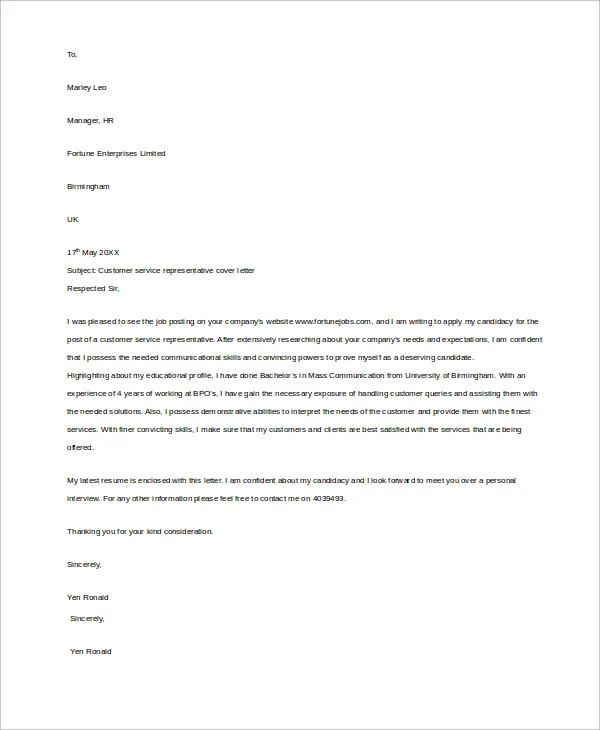Crafting a Customer Service Rep Cover Letter
A customer service representative cover letter is your first opportunity to make a strong impression on a potential employer. It is a crucial document that accompanies your resume and provides a detailed look at your skills, experience, and personality. A well-crafted cover letter can significantly increase your chances of getting an interview and ultimately landing the job. In this guide, we will explore how to create a compelling customer service rep cover letter that effectively highlights your qualifications and distinguishes you from other candidates. We will cover everything from formatting and content to common mistakes to avoid, as well as provide sample letters to guide you.
Understanding the Purpose of a Cover Letter
The primary purpose of a customer service rep cover letter is to introduce yourself and express your interest in a specific position. It serves as a personalized introduction, allowing you to elaborate on your qualifications in a way that a resume alone cannot. The cover letter should also demonstrate your understanding of the company and the role, and why you are a great fit. It’s your chance to show your enthusiasm, highlight key skills, and connect with the hiring manager on a personal level. A well-written cover letter increases the likelihood of your application standing out.
Highlighting Relevant Skills
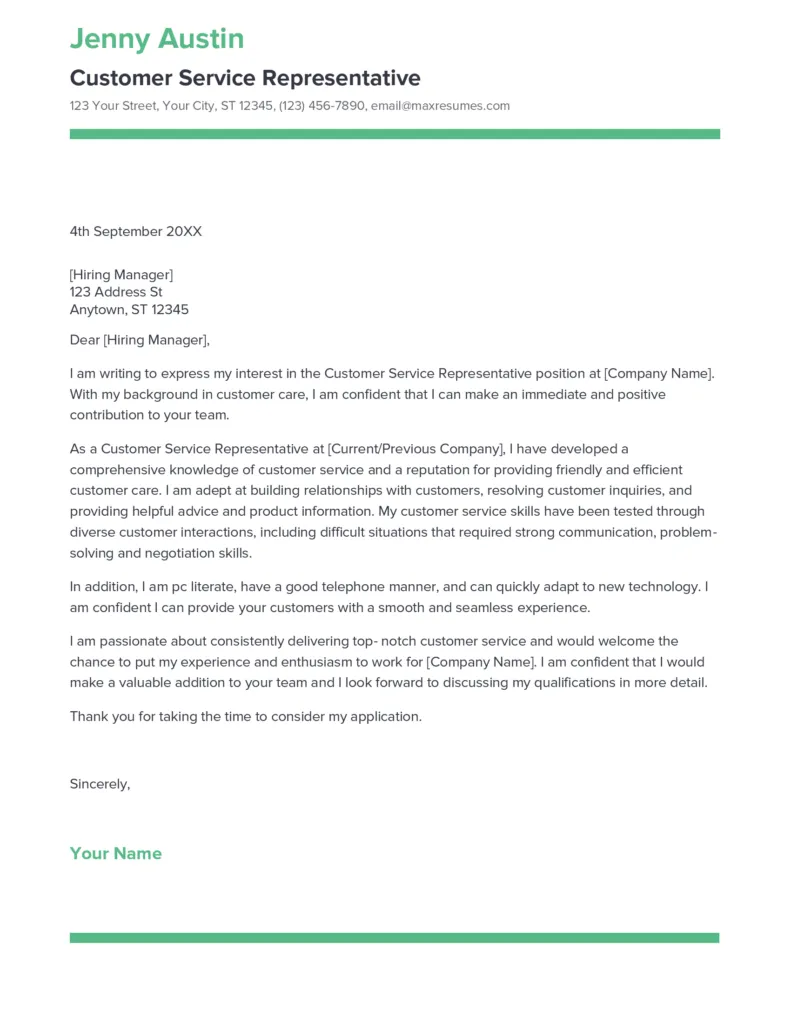
Customer service roles require a unique blend of skills, and it’s essential to showcase these effectively in your cover letter. Focus on the skills that align with the job description and are most relevant to the role you’re applying for. Quantify your achievements whenever possible, using specific examples to demonstrate your abilities. For instance, instead of saying you have ’excellent communication skills’, explain how you resolved a customer issue and turned a negative experience into a positive one.
Communication Skills
Exceptional communication skills are the cornerstone of any successful customer service representative. In your cover letter, emphasize your ability to communicate clearly and effectively, both verbally and in writing. Mention your experience in active listening, providing clear and concise explanations, and adapting your communication style to suit diverse customer needs. Include specific examples, such as resolving conflicts, providing product information, or explaining complex processes in an easy-to-understand manner. Highlighting your ability to build rapport and maintain a positive tone is also crucial.
Problem-Solving Abilities
Customer service reps are often the first point of contact for customers facing problems. Your cover letter should clearly demonstrate your problem-solving abilities. Provide examples of situations where you identified customer issues, analyzed them, and implemented effective solutions. Describe your process, from gathering information to taking appropriate action. Demonstrate that you are able to remain calm under pressure, think critically, and find creative solutions to customer issues. Mentioning your ability to work independently and as part of a team is a bonus.
Empathy and Patience
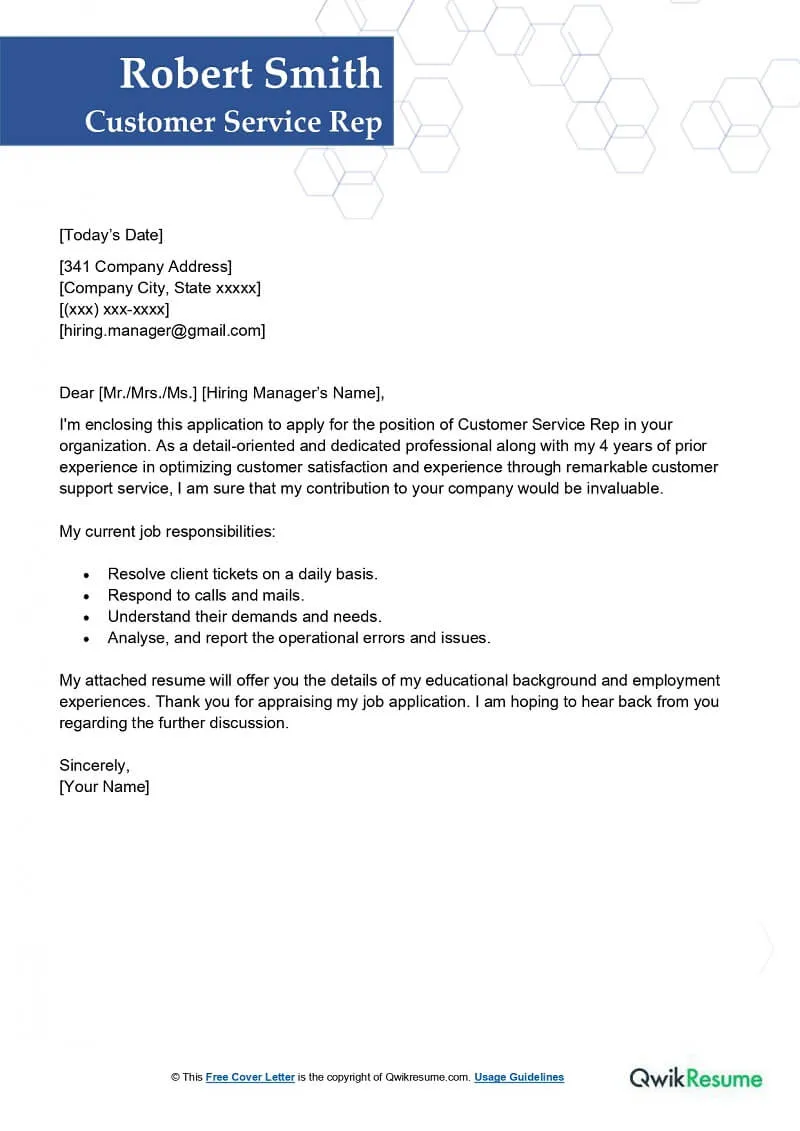
Empathy and patience are essential traits for anyone in customer service. Show how you understand and respond to customers’ emotions. Provide instances where you successfully handled difficult customers or challenging situations with compassion and understanding. Describe how you actively listened to customers’ concerns and provided solutions that met their needs while maintaining a positive and supportive demeanor. These soft skills help demonstrate your ability to handle customer issues effectively and create a positive experience.
Showcasing Experience
Your cover letter should highlight your relevant customer service experience. Briefly describe your previous roles, focusing on responsibilities and accomplishments. Instead of simply listing your job duties, emphasize the results you achieved, such as increased customer satisfaction, improved efficiency, or successful resolution of customer complaints. Use quantifiable metrics whenever possible, like ‘increased customer satisfaction scores by 15%’ or ‘resolved an average of 30 customer inquiries per day.’ Providing specific examples of your experience will make your application more impactful.
Formatting Your Cover Letter
A well-formatted cover letter is crucial for making a positive first impression. It should be clean, easy to read, and professional in appearance. Follow these guidelines to ensure your cover letter is polished and appealing to potential employers.
Header and Contact Information

Begin your cover letter with your contact information, including your name, address, phone number, and email address. The hiring manager’s contact information should be included, which usually consists of the name, title, company, and address. This information should be aligned to the left or right and should be easily accessible. This ensures that the hiring manager can easily contact you. Making sure the contact information is correct is crucial to being considered.
Salutation and Opening
Start with a professional salutation, such as ‘Dear Mr./Ms./Mx. [Last Name].’ If you do not know the hiring manager’s name, use a general greeting like ‘Dear Hiring Manager’. Your opening paragraph is essential for capturing attention. State the position you’re applying for and where you saw the job posting. Briefly mention what makes you a strong candidate and your enthusiasm for the opportunity. Clearly state your purpose for writing and your interest in the role.
Body Paragraphs
The body of your cover letter is where you highlight your skills, experience, and achievements. Use 2-3 paragraphs to elaborate on your qualifications, providing specific examples that support your claims. Tailor each paragraph to the requirements of the job description. Focus on why you are the best fit for the company and the role. Use action verbs to describe your accomplishments, and always quantify your achievements with numbers whenever possible.
The First Paragraph: Grabbing Attention
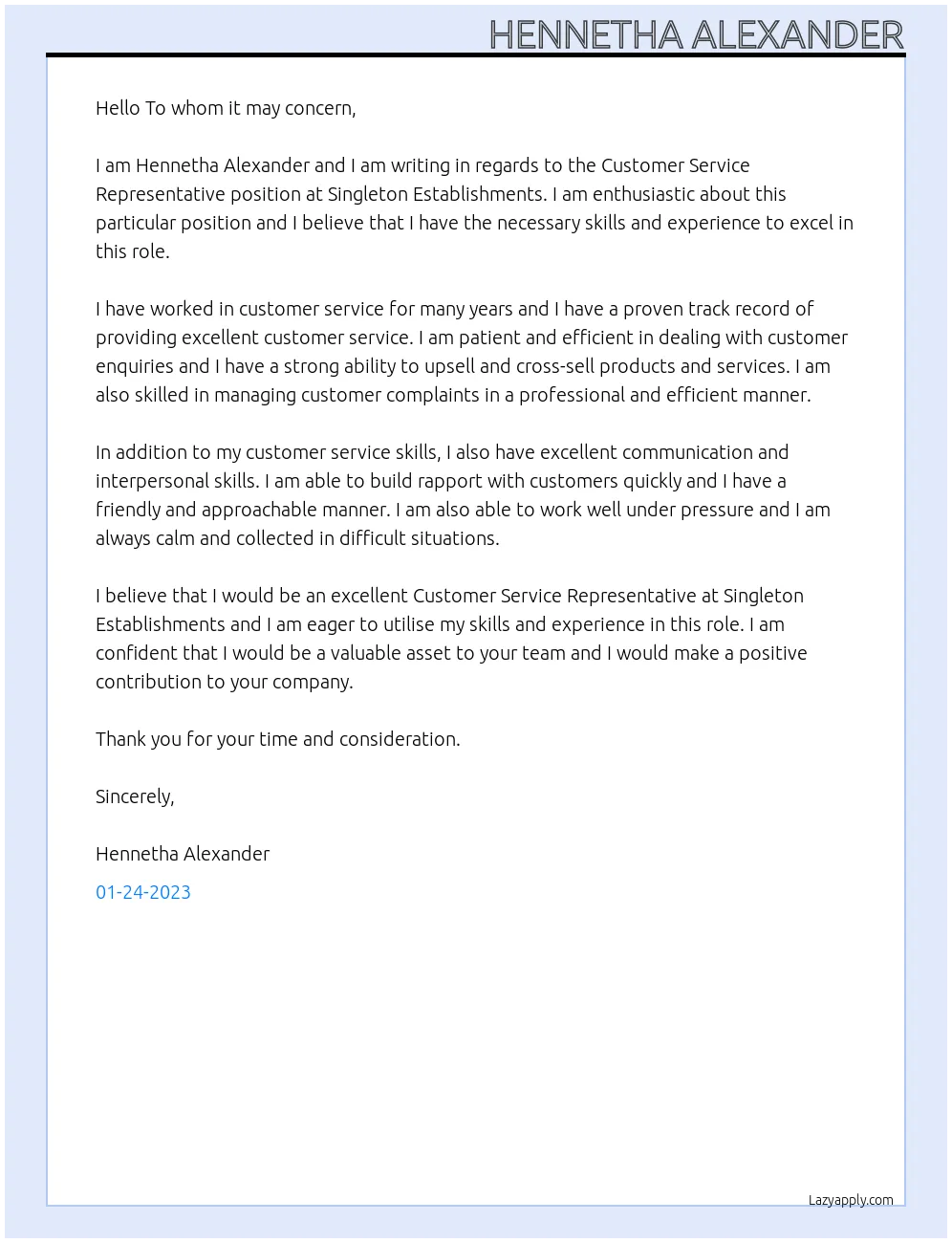
Your first paragraph should clearly state the position you are applying for and express your interest in the role. Briefly mention where you saw the job posting. Highlight something that initially attracted you to the position or company. State your strongest qualification or a relevant skill to immediately capture the reader’s attention. Demonstrate enthusiasm and make a strong first impression.
The Second Paragraph: Skills and Achievements
In the second paragraph, delve into your relevant skills and achievements. Provide specific examples from your previous customer service roles. Quantify your accomplishments whenever possible. Use action verbs to describe what you did and the results you achieved. Focus on how your skills align with the job requirements. Discuss any special projects or contributions you made that are relevant to the role. Be clear about your contributions and make sure the information is concise.
The Third Paragraph: Company Alignment
In the third paragraph, express your understanding of the company’s mission and values. Explain why you want to work for them and how your skills and experience align with their culture. Show that you’ve researched the company and are genuinely interested in their work. Mention specific aspects of the company that appeal to you. Demonstrate your enthusiasm for the opportunity, the role, and the company overall. Show that your values match the company’s values.
Closing and Call to Action
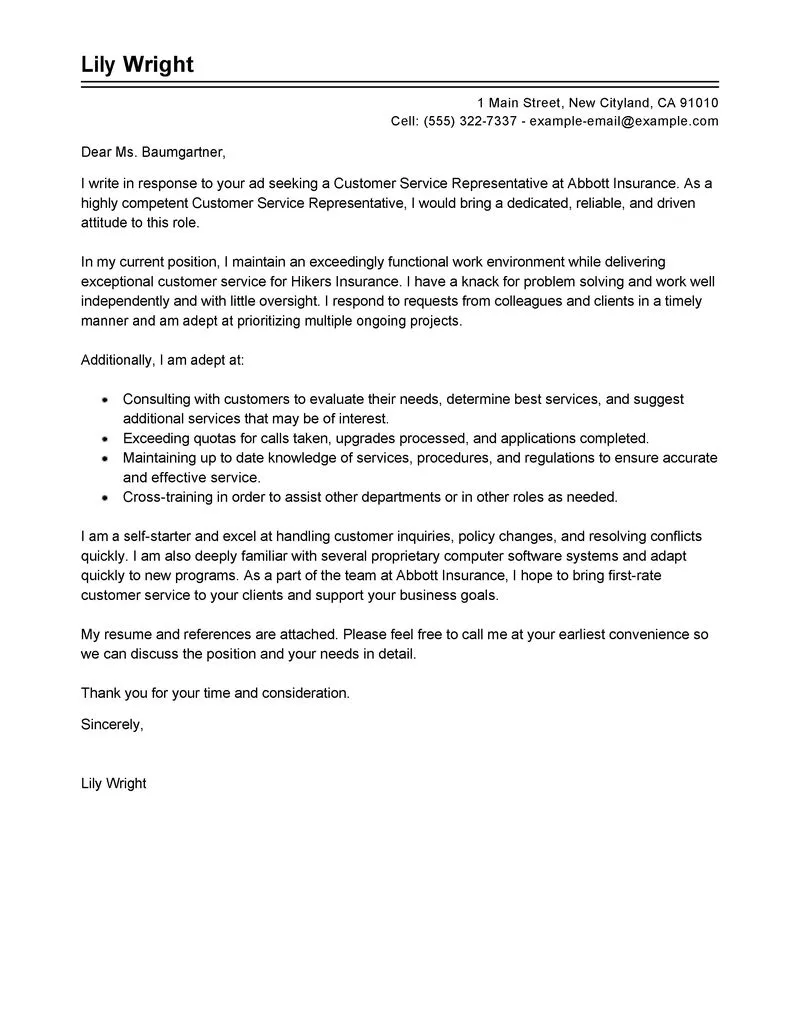
End your cover letter with a strong closing statement. Reiterate your interest in the position and your appreciation for the opportunity. Include a call to action, such as suggesting a follow-up or stating your availability for an interview. Thank the hiring manager for their time and consideration. End the letter with a professional closing, such as ‘Sincerely’ or ‘Best regards,’ followed by your name.
Proofreading and Editing
Before submitting your cover letter, carefully proofread and edit it to eliminate any errors. Make sure the content is clear and easy to read. Review your cover letter for any grammatical errors, typos, and inconsistencies. Reading your cover letter aloud can help you catch errors. Consider having a friend, colleague, or career counselor review your cover letter for feedback.
Common Mistakes to Avoid
Avoid common mistakes that can hurt your chances of landing an interview. Focusing on these common pitfalls can significantly improve your cover letter and application.
Generic Language

Avoid using generic phrases or clichés that do not provide a unique or compelling picture of your skills and experience. Use specific examples and tailor your language to the specific job description and company. Do not use generic phrases such as ‘hardworking’ and ’team player.’ Instead, provide examples that support that statement, such as, ‘Increased customer satisfaction scores by 15% through proactive problem-solving.’ Show the reader what you did and the outcomes you achieved.
Typos and Grammatical Errors
Typos and grammatical errors can create a negative impression of your attention to detail and professionalism. Always proofread your cover letter carefully before submitting it. Use a grammar checker to identify potential errors. It’s crucial to show the hiring manager that you have the attention to detail that is important for the role.
Lack of Personalization
A cover letter should be personalized to the specific job and company. Avoid sending a generic cover letter to multiple employers. Show that you have researched the company and understand their needs. Mention the name of the hiring manager if possible. Tailor your cover letter to the specific requirements of the job description to highlight your qualifications.
Tailoring Your Cover Letter
Customizing your cover letter to each job you apply for increases your chances of success. Customizing your cover letter demonstrates to the hiring manager that you have taken the time to understand the company and the role. Here are some tips on tailoring your cover letter.
Researching the Company
Before writing your cover letter, research the company’s mission, values, and recent activities. Understand their products or services and their target customers. Visit the company’s website and social media profiles. Highlight how your skills and experience align with the company’s values and goals. This is crucial in showing the company you understand what they do and how you fit into their operations.
Matching Skills to Job Requirements
Carefully review the job description and identify the key skills and qualifications the employer is seeking. Highlight the skills and experience that directly match these requirements. Provide specific examples of how you have demonstrated those skills in the past. Customize your language to reflect the specific terminology used in the job description. This ensures that your cover letter aligns with the employer’s needs.
Customer Service Cover Letter Samples
Reviewing customer service cover letter samples can provide valuable insights into how to structure and write your own letter. These samples illustrate different approaches and formats. Remember to customize these templates to reflect your specific experience and the job requirements. Here are a few examples to guide you.
Sample 1: Entry-Level Customer Service
An entry-level cover letter should focus on transferable skills, enthusiasm, and eagerness to learn. Highlight any customer service experience, even if it’s from part-time jobs or volunteer work. Emphasize soft skills like communication, problem-solving, and empathy. Show your eagerness to take on the job and make a contribution to the company’s goals. If you have no direct customer service experience, focus on experiences that show your ability to work with people and resolve issues.
Sample 2: Experienced Customer Service Representative
An experienced cover letter should highlight your proven track record and quantifiable achievements. Use specific examples to demonstrate your successes in previous roles. Quantify achievements using metrics like customer satisfaction scores and issue resolution rates. Describe your experience in training new hires or leading a team. Showcase your expertise in conflict resolution, problem-solving, and customer relationship management. Highlight any special skills that make you an exceptional candidate.
Sample 3: Customer Service Lead/Manager
For a customer service lead or manager position, emphasize your leadership and management skills. Highlight your experience in team leadership, training, and performance management. Provide examples of how you improved team performance or customer satisfaction. Show your ability to analyze data, create strategies, and implement solutions. Quantify your achievements. Show a commitment to continuous improvement in customer service. Provide any certifications you may have and how they have helped you.
Finalizing and Submitting Your Cover Letter
Once you’ve completed your cover letter, take these final steps before submitting your application. Double-check the cover letter and the job requirements for any errors. Make sure you’ve included all the necessary documents. Proofread your cover letter and resume one last time to ensure there are no errors. Use a professional font and format. Submit your application as directed in the job posting. Follow up if necessary, but don’t be overbearing. Good luck!
